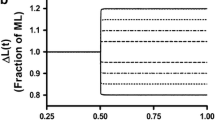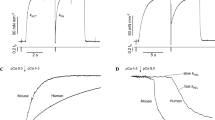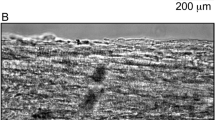Abstract
In mammalian ventricles, two myosin heavy chain (MHC) isoforms have been identified. Small animals express α-MHC, whereas large animals express β-MHC, which contribute to a large difference in the heart rate. Sprague–Dawley rats possessing ~99% α-MHC were treated with propylthiouracil to result in 100% β-MHC. Papillary muscles were skinned, dissected into small fibers, and used for experiments. To understand the functional difference between α-MHC and β-MHC, skinned-fibers were activated under the intracellular ionic conditions: 5 mM MgATP, 1 mM Mg2+, 8 mM Pi, 200 mM ionic strength, pH 7.00 at 25 °C. Small amplitude sinusoidal length oscillations were applied in the frequency range 0.13–100 Hz (corresponding time domain: 1.6–1200 ms), and effects of Ca2+, Pi, and ATP were studied. The results show that Ca2+ sensitivity was slightly less (10–15%) in β-MHC than α-MHC containing fibers. Sinusoidal analysis at pCa 4.66 (full Ca2+ activation) demonstrated that, the apparent rate constants were 2–4× faster in α-MHC containing fibers. The ATP study demonstrated that, in β-MHC containing fibers, K 1 (ATP association constant) was greater (1.7×), k 2 and k −2 (cross-bridge detachment and its reversal rate constants) were smaller (×0.6). The Pi study demonstrated that, in β-MHC containing fibers, k 4 (rate constant of the force-generation step) and k −4 were smaller (0.75× and 0.25×, respectively), resulting in greater K 4 (3×). There were no differences in active tension, rigor stiffness, or K 2 (equilibrium constant of the cross-bridge detachment step). Our study further demonstrated that there were no differences in parameters between fibers obtained from left and right ventricles, but with an exception in K 5 (Pi association constant).










Similar content being viewed by others
References
Andrews MA, Maughan DW, Nosek TM, Godt RE (1991) Ion-specific and general ionic effects on contraction of skinned fast-twitch skeletal muscle from the rabbit. J Gen Physiol 98:1105–1125
Bloemink MJ, Adamek N, Reggiani C, Geeves MA (2007) Kinetic analysis of the slow skeletal myosin MHC-1 isoform from bovine masseter muscle. J Mol Biol 373:1184–1197. doi:10.1016/j.jmb.2007.08.050
Caremani M, Dantzig J, Goldman YE, Lombardi V, Linari M (2008) Effect of inorganic phosphate on the force and number of myosin cross-bridges during the isometric contraction of permeabilized muscle fibers from rabbit psoas. Biophys J 95:5798–5808. doi:10.1529/biophysj.108.130435
Dantzig J, Goldman Y, Millar NC, Lacktis J, Homsher E (1992) Reversal of the cross-bridge force-generating transition by the photogeneration of phosphate in rabbit psoas muscle fibers. J Physiol 451:247–278
Davis JS, Epstein ND (2009) Mechanistic role of movement and strain sensitivity in muscle contraction. Proc Natl Acad Sci USA 106:6140–6145. doi:10.1073/pnas.0812487106
Deacon JC, Bloemink MJ, Rezavandi H, Geeves MA, Leinwand LA (2012) Erratum to: identification of functional differences between recombinant human alpha and beta cardiac myosin motors. Cell Mol Life Sci 69:4239–4255. doi:10.1007/s00018-012-1111-5
Fitzsimons DP, Patel JR, Moss RL (1998) Role of myosin heavy chain composition in kinetics of force development and relaxation in rat myocardium. J Physiol 513:171–183. doi:10.1111/j.1469-7793.1998.171by.x
Ford SJ, Chandra M (2012) The effects of slow skeletal troponin I expression in the murine myocardium are influenced by development-related shifts in myosin heavy chain isoform. J Physiol 590:6047–6063. doi:10.1113/jphysiol.2012.240085
Fortune NS, Geeves MA, Ranatunga KW (1991) Tension responses to rapid pressure release in glycerinated rabbit muscle fibers. Proc Natl Acad Sci USA 88:7323–7327
Galler S, Puchert E, Gohlsch B, Schmid D, Pette D (2002) Kinetic properties of cardiac myosin heavy chain isoforms in rat. Pflug Arch 445:218–223. doi:10.1007/s00424-002-0934-6
Godt RE, Maughan DW (1988) On the composition of the cytosol of relaxed skeletal muscle of the frog. Am J Physiol 254:C591–C604
Heinl P, Kuhn HJ, Ruegg JC (1974) Tension responses to quick length changes of glycerinated skeletal muscle fibres from the frog and tortoise. J Physiol 237:243–258
Huxley AF (1974) Muscular contraction. J Physiol 243:1–43
Kawai M (1978) Head rotation or dissociation?: a study of exponential rate processes in chemically skinned rabbit muscle fibers when MgATP concentration is changed. Biophys J 22:97–103
Kawai M, Brandt PW (1976) Two rigor states in skinned crayfish single muscle fibers. J Gen Physiol 68:267–280
Kawai M, Brandt PW (1980) Sinusoidal analysis: a high resolution method for correlating biochemical reactions with physiological processes in activated skeletal muscles of rabbit, frog and crayfish. J Muscle Res Cell Motil 1:279–303
Kawai M, Halvorson H (1989) Role of MgATP and MgADP in the crossbridge kinetics in chemically skinned rabbit psoas fibers. Study of a fast exponential process C. Biophys J 55:595–603
Kawai M, Halvorson HR (1991) Two step mechanism of phosphate release and the mechanism of force generation in chemically skinned fibers of rabbit psoas. Biophys J 59:329–342
Kawai M, Halvorson HR (2007) Force transients and minimum cross-bridge models in muscular contraction. J Muscle Res Cell Motil 28:371–395
Kawai M, Zhao Y (1993) Cross-bridge scheme and force per cross-bridge state in skinned rabbit psoas muscle fibers. Biophys J 65:638–651
Kawai M, Guth K, Winnikes K, Haist C, Ruegg JC (1987) The effect of inorganic phosphate on the ATP hydrolysis rate and the tension transients in chemically skinned rabbit psoas fibers. Pflug Arch 408:1–9
Kawai M, Saeki Y, Zhao Y (1993) Cross-bridge scheme and the kinetic constants of elementary steps deduced from chemically skinned papillary and trabecular muscles of the ferret. Circ Res 73:35–50
Layland J, Solaro RJ, Shah AM (2005) Regulation of cardiac contractile function by troponin I phosphorylation. Cardiovasc Res 66:12–21. doi:10.1016/j.cardiores.2004.12.022
Lompre AM, Mercadier JJ, Wisnewsky C, Bouveret P, Pantaloni C, D’Albis A, Schwartz K (1981) Species- and age-dependent changes in the relative amounts of cardiac myosin isoenzymes in mammals. Dev Biol 84:286–290
Lu X, Tobacman LS, Kawai M (2006) Temperature-dependence of isometric tension and cross-bridge kinetics of cardiac muscle fibers reconstituted with a tropomyosin internal deletion mutant. Biophys J 91:4230–4240. doi:10.1529/biophysj.106.084608
Malmqvist UP, Aronshtam A, Lowey S (2004) Cardiac myosin isoforms from different species have unique enzymatic and mechanical properties. Biochemistry 43:15058–15065. doi:10.1021/bi0495329
McNally EM, Kraft R, Bravo-Zehnder M, Taylor DA, Leinwand LA (1989) Full-length rat alpha and beta cardiac myosin heavy chain sequences: comparisons suggest a molecular basis for functional differences. J Mol Biol 210:665–671
Michael JJ, Chandra M (2015) Functional effects of the H1-Helix of rat cardiac troponin T on crossbridge detachment rate is differently modulated by α- and β-Myosin heavy chain isoforms. Biophys J 108:596a. doi:10.1016/j.bpj.2014.11.3245
Michael JJ, Chandra M (2016) Interplay between the effects of dilated cardiomyopathy mutation (R206L) and the protein kinase C phosphomimic (T204E) of rat cardiac troponin T are differently modulated by alpha- and beta-myosin heavy chain isoforms. J Am Heart Assoc 4:e002777. doi:10.1161/jaha.115.002777
Michael JJ, Gollapudi SK, Ford SJ, Kazmierczak K, Szczesna-Cordary D, Chandra M (2012) Deletion of 1-43 amino acids in cardiac myosin essential light chain blunts length dependency of Ca2+ sensitivity and crossbridge detachment kinetics. Am J Physiol Heart Circ Physiol 304:H253–H259. doi:10.1152/ajpheart.00572.2012
Michael JJ, Gollapudi SK, Chandra M (2014) Effects of pseudo-phosphorylated rat cardiac troponin T are differently modulated by alpha- and beta-myosin heavy chain isoforms. Basic Res Cardiol 109:442–457. doi:10.1007/s00395-014-0442-9
Michael JJ, Gollapudi SK, Chandra M (2016) Interplay between the effects of a Protein Kinase C phosphomimic (T204E) and a dilated cardiomyopathy mutation (K211Δ or R206 W) in rat cardiac troponin T blunts the magnitude of muscle length-mediated crossbridge recruitment against a β-myosin heavy chain background. J Muscle Res Cell Motil. doi:10.1007/s10974-016-9448-2
Millar NC, Geeves MA (1988) Protein fluorescence changes associated with ATP and adenosine 5′-[gamma-thio]triphosphate binding to skeletal muscle myosin subfragment 1 and actomyosin subfragment 1. Biochem J 249:735–743
Miller T et al (2001) Abnormal contractile function in transgenic mice expressing a familial hypertrophic cardiomyopathy-linked troponin T (I79 N) mutation. J Biol Chem 276:3743–3755. doi:10.1074/jbc.M006746200
Opie LH, Mansford KR, Owen P (1971) Effects of increased heart work on glycolysis and adenine nucleotides in the perfused heart of normal and diabetic rats. Biochem J 124:475–490
Pagani ED, Julian FJ (1984) Rabbit papillary muscle myosin isozymes and the velocity of muscle shortening. Circ Res 54:586–594
Palmiter KA, Tyska MJ, Dupuis DE, Alpert NR, Warshaw DM (1999) Kinetic differences at the single molecule level account for the functional diversity of rabbit cardiac myosin isoforms. J Physiol 519(Pt 3):669–678
Pope B, Hoh JF, Weeds A (1980) The ATPase activities of rat cardiac myosin isoenzymes. FEBS Lett 118:205–208
Ritchie MD, Geeves MA, Woodward SK, Manstein DJ (1993) Kinetic characterization of a cytoplasmic myosin motor domain expressed in Dictyostelium discoideum. Proc Natl Acad Sci USA 90:8619–8623
Roth K et al (1989) Noninvasive quantitation of phosphorus metabolites in human tissue by NMR spectroscopy. J Magn Reson 81:299–311
Song W et al (2011) Molecular mechanism of the E99K mutation in cardiac actin (ACTC Gene) that causes apical hypertrophy in man and mouse. J Biol Chem 286:27582–27593
Stelzer JE, Brickson SL, Locher MR, Moss RL (2007) Role of myosin heavy chain composition in the stretch activation response of rat myocardium. J Physiol 579:161–173. doi:10.1113/jphysiol.2006.119719
Sweeney HL, Houdusse A (2010) Structural and functional insights into the Myosin motor mechanism. Annu Rev Biophys 39:539–557. doi:10.1146/annurev.biophys.050708.133751
Tanner BC, Wang Y, Robbins J, Palmer BM (2014) Kinetics of cardiac myosin isoforms in mouse myocardium are affected differently by presence of myosin binding protein-C. J Muscle Res Cell Motil 35:267–278. doi:10.1007/s10974-014-9390-0
Tesi C, Colomo F, Nencini S, Pirodi N, Poggesi C (2000) The effect of inorganic phosphate on force generation in single myofibrils from rabbit skeletal muscle. Biophys J 78:3081–3092
Wang L, Muthu P, Szczesna-Cordary D, Kawai M (2013a) Characterizations of myosin essential light chain’s N-terminal truncation mutant Delta43 in transgenic mouse papillary muscles by using tension transients in response to sinusoidal length alterations. J Muscle Res Cell Motil 34:93–105. doi:10.1007/s10974-013-9337-x
Wang L, Muthu P, Szczesna-Cordary D, Kawai M (2013b) Diversity and similarity of motor function and cross-bridge kinetics in papillary muscles of transgenic mice carrying myosin regulatory light chain mutations D166V and R58Q. J Mol Cell Cardiol 62:153–163
Wang Y et al (2013c) Cardiac myosin isoforms exhibit differential rates of MgADP release and MgATP binding detected by myocardial viscoelasticity. J Mol Cell Cardiol 54:1–8. doi:10.1016/j.yjmcc.2012.10.010
Wang L, Sadayappan S, Kawai M (2014) Cardiac myosin binding protein C phosphorylation affects cross-bridge cycle’s elementary steps in a site-specific manner. PLoS ONE 0113417:1–21
Wannenburg T, Heijne GH, Geerdink JH, Van-Den-Dool HW, Janssen PM, DeTombe PP (2000) Cross-bridge kinetics in rat myocardium: effect of sarcomere length and calcium activation. Am J Physiol 279:H779–H790
Wolska BM et al (1999) Correlation between myofilament response to Ca2+ and altered dynamics of contraction and relaxation in transgenic cardiac cells that express beta-tropomyosin. Circ Res 84:745–751
Funding
This work was supported by a grant from The American Heart Association 13GRNT16810043 to MK, National Heart, Lung, and Blood Institute Grant R01-HL-075643 to MC, and a Poncin Fellowship to JJM.
Author information
Authors and Affiliations
Corresponding author
Ethics declarations
Conflict of interest
None.
Rights and permissions
About this article
Cite this article
Kawai, M., Karam, T.S., Michael, J.J. et al. Comparison of elementary steps of the cross-bridge cycle in rat papillary muscle fibers expressing α- and β-myosin heavy chain with sinusoidal analysis. J Muscle Res Cell Motil 37, 203–214 (2016). https://doi.org/10.1007/s10974-016-9456-2
Received:
Accepted:
Published:
Issue Date:
DOI: https://doi.org/10.1007/s10974-016-9456-2




